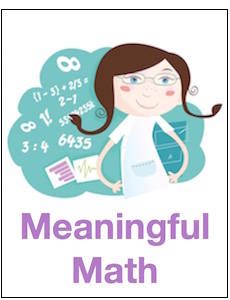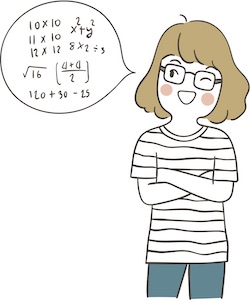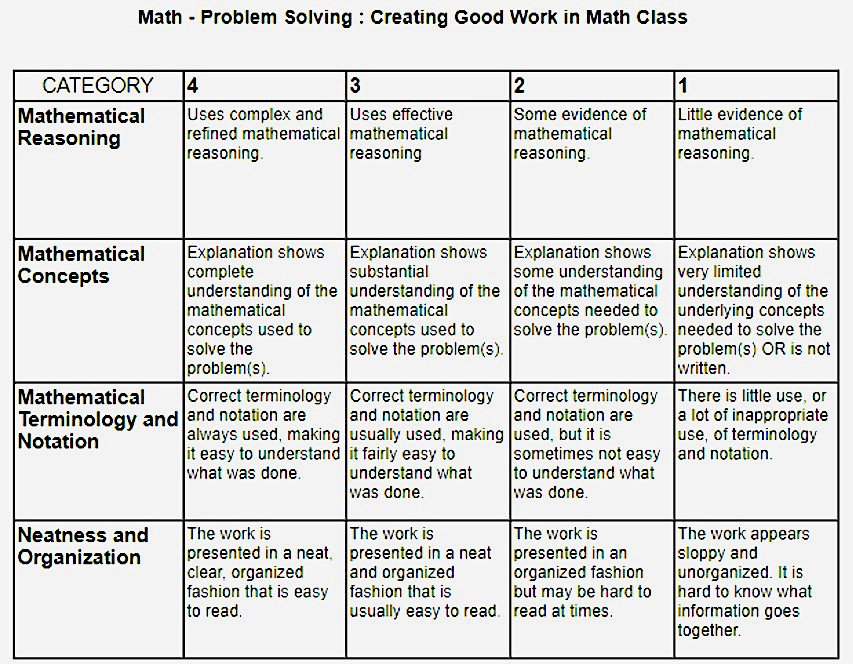Getting Math Students to Show Their Work
A MiddleWeb Blog

She said that she preferred a certain method because it made more sense logically and it was easier for her to see what the students were thinking. That was of first importance.
I really thought about that for several days. I agree about the importance of understanding what students are thinking and for them to be able to communicate what they are thinking through their work.
Ultimately, what’s most important though, is that they understand what they are doing and why.
Communicating math ideas through their work
At my school we have gone back to a full 5-day week with all the students coming to school each day, except those who have chosen to go fully virtual and avoid physical school altogether.
Now that most of us are face to face, I have had an opportunity to see more of their work. After learning virtually for several weeks, many students got in the habit of showing little to no evidence of the work they did to reach their conclusions. In general, they were out of the practice of writing anything down.
In the current climate, it’s more important than ever to remind them to communicate their thoughts logically and clearly. But how do you get students to think about concepts in a meaningful way and then communicate those thoughts clearly? I decided I’d start by asking students what they thought good math work looked like.
What does good math work look like?

Others said it this way: “I can do the math but I can’t write it down and explain it.” To be fair, I have had some students who could do a lot of work in their heads and get the right answer, but not many.
After listening to a lot of answers to my question, I concluded that my students don’t know what good mathematical work looks like.
I’m not sure I know exactly either, although I can easily identify bad work. And I do know that I haven’t explicitly taught or even expected them to demonstrate good work. In the past, I would say, to get full credit you have to “show your work” or “show your steps.”
What does that even mean to my students?
“Show every step” is vague and unhelpful. Besides it’s not always necessary to show every step. The point of their work should be to help them think logically about the problem, and to help me follow their thinking. I don’t want it to be a hoop to jump through or just something to check off a list.
So here’s what I did…
To start with I needed to determine what I consider to be good math work. What do I like to see when grading, and what helps me when I am personally working math problems? I decided that characteristics of good work would be:
✻ neat and organized, easy to read
✻ math symbols used correctly
✻ provides evidence that they understand the math concepts
✻ provides evidence that they have reasoned and thought logically about a problem.
Now that I had an idea of what good work looks like, I had to get this across to my students. I spent several days thinking about how I was going to accomplish this. (I tried researching what good math work looks like and I didn’t find a lot. I did find this website that had good suggestions: Teach Thought.)
I decided to focus on three areas: communication, rubrics, and studying examples of good student work. I have elaborated a little bit below.
1. Regular Communication
I plan to continue to gently remind students of the importance of creating good work in math class. Just talking about it with them and letting them know it should be priority is helpful. After we discussed what their work should look like for one day, I started to notice a little improvement in most of my students’ work. So just addressing the issue is helpful.
Also, I think it’s a good idea to get their feedback and their ideas. It helps if they can share in deciding what good work looks like. I also like to walk around the room and call attention to individual students who are showing good work.
2. Examples of Good Student Work
Students can’t just be encouraged to create good work. They also need to be shown what it looks like. Just like their English teachers explicitly teach them how to write a good paper, math teachers need to show students how to create good work and provide evidence for their thinking.
One way I plan to do this is by sharing exemplary samples of student work. It might also help to share examples where the work is not as good and let students provide suggestions as to how it could be improved. It’s interesting because when I teach AP Statistics I always use exemplary student samples to help students evaluate their own work. I don’t know why I didn’t think to do it in all my classes.
3. Rubrics
I plan to provide students a rubric so they can grade their work samples. For this, I am more interested in students thinking logically and reasonably and communicating than thinking they are working to get the right answer. I found many good rubrics dealing with problem solving and showing work in math class on rubistar. Here’s my rubric:
In the end I made my rubric by borrowing bits and pieces from several different rubrics. If you haven’t used rubistar before, it’s pretty easy and there are lots of pre-made rubrics. I have included mine, but I’m sure it will change as the year goes on. I know that I will need to discuss it with my students, and we will have to decide what each of the categories entails and requires.
Updates to Come
This will be one of those year-long goals, so I plan to write an update and share what worked and what didn’t. If anyone has any suggestions, please share. This is an area where I know I have lots of room for improvement. It’s important to me because I’m convinced that if students can learn to think logically and communicate their work clearly, that is a skill that will go beyond just math class and will be helpful in so many different areas.
































I really like your thoughts and steps to help students see what good mathematical work looks like. A little suggestion that I use is to tell students to “make their thinking visible”. They have heard “show your work” in math class for many years. This is a different way to express that to students.
Showing or displaying students’ work is a good step. Here is a document that I use for something I call “Correct Solution to a Problem Missed” which has students correct a problem missed on an assessment. And here is another idea: A “Diamond Paper” that gives students four ways to show what they know.
I love both of your ideas!. Thanks so much for sharing. I’m stealing to share with the teachers I mentor.
All I can say is “Wow”! The documents you shared are awesome! You’ve obviously thought a lot about how to get students to show what they are thinking. I love your diamond paper and I plan to use it immediately! We are working on factoring to solve quadratic equations and this will work beautifully. They can show the visual (graphical) and the numerical representations easily. Thank you so much for sharing your expertise!
My challenge, in this Hybrid world we now teach in, is that there is no easy way to show your thinking. We transitioned to a web-based curriculum (fortunately) 2 years ago, which saved us when we went Distance, and when we came back in Hybrid-mode this school year, we were admonished to keep things electronic, to be equitable between those at home and those at school – everyone does digital work, no papers change hands.
So outside of having them take a picture and upload each page of their work, I really can’t see what they’re doing.
It’s not optimal, I know, because the mathematical process is just as important as the final result, but I am sort of stuck with just seeing the end result and trusting that the work behind the correct answer was done properly.
Thank you for your comment! I completely understand, I think having to teach virtually is what made me realize how much I depended on seeing students’ work. We are currently face to face for the most part, with a small percentage of students choosing fully virtual learning. However, we could also go back to fully virtual or a hybrid schedule at any time. So I’ve been thinking about how I can see what that they are doing when in a virtual setting. There are no easy answers. We use Canvas and students can take a picture of their work and upload it but it is really hard to look at math work on a computer screen all day. Then giving them feed back is very time consuming. The other issue I have found is that students don’t like to write anything down if they don’t have to so a lot of students don’t work through problems on paper when they are learning virtually. I’m going to continue to think about this and try to work on some solutions. I really appreciate you bringing this up!
How do you handle the math apps that they use…. you really can’t tell if they are understanding based on the visual work?
I want to try to give students some “bonus” for showing proper/adequate work…. but not sure.